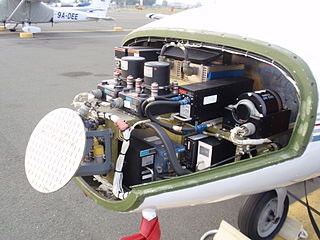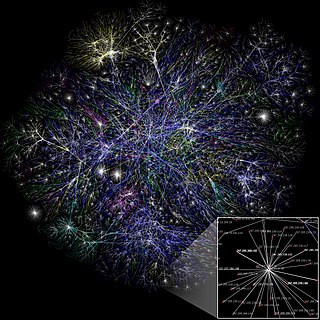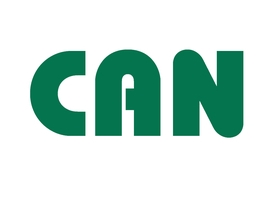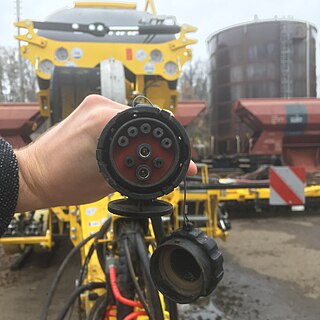
Avionics are the electronic systems used on aircraft. Avionic systems include communications, navigation, the display and management of multiple systems, and the hundreds of systems that are fitted to aircraft to perform individual functions. These can be as simple as a searchlight for a police helicopter or as complicated as the tactical system for an airborne early warning platform.

In computer architecture, a bus is a communication system that transfers data between components inside a computer, or between computers. This expression covers all related hardware components and software, including communication protocols.

Network topology is the arrangement of the elements of a communication network. Network topology can be used to define or describe the arrangement of various types of telecommunication networks, including command and control radio networks, industrial fieldbusses and computer networks.
In the seven-layer OSI model of computer networking, the physical layer or layer 1 is the first and lowest layer: the layer most closely associated with the physical connection between devices. The physical layer provides an electrical, mechanical, and procedural interface to the transmission medium. The shapes and properties of the electrical connectors, the frequencies to transmit on, the line code to use and similar low-level parameters, are specified by the physical layer.

In telecommunication and data transmission, serial communication is the process of sending data one bit at a time, sequentially, over a communication channel or computer bus. This is in contrast to parallel communication, where several bits are sent as a whole, on a link with several parallel channels.

A controller area network (CAN) is a vehicle bus standard designed to enable efficient communication primarily between electronic control units (ECUs). Originally developed to reduce the complexity and cost of electrical wiring in automobiles through multiplexing, the CAN bus protocol has since been adopted in various other contexts. This broadcast-based, message-oriented protocol ensures data integrity and prioritization through a process called arbitration, allowing the highest priority device to continue transmitting if multiple devices attempt to send data simultaneously, while others back off. Its reliability is enhanced by differential signaling, which mitigates electrical noise. Common versions of the CAN protocol include CAN 2.0, CAN FD, and CAN XL which vary in their data rate capabilities and maximum data payload sizes.

An electronic control unit (ECU), also known as an electronic control module (ECM), is an embedded system in automotive electronics that controls one or more of the electrical systems or subsystems in a car or other motor vehicle.
Society of Automotive Engineers standard SAE J1939 is the vehicle bus recommended practice used for communication and diagnostics among vehicle components. Originating in the car and heavy-duty truck industry in the United States, it is now widely used in other parts of the world.
Aeronautical Radio, Incorporated (ARINC), established in 1929, was a major provider of transport communications and systems engineering solutions for eight industries: aviation, airports, defense, government, healthcare, networks, security, and transportation. ARINC had installed computer data networks in police cars and railroad cars and also maintains the standards for line-replaceable units.
MIL-STD-1553 is a military standard published by the United States Department of Defense that defines the mechanical, electrical, and functional characteristics of a serial data bus. It was originally designed as an avionic data bus for use with military avionics, but has also become commonly used in spacecraft on-board data handling (OBDH) subsystems, both military and civil, including use on the James Webb space telescope. It features multiple redundant balanced line physical layers, a (differential) network interface, time-division multiplexing, half-duplex command/response protocol, and can handle up to 31 Remote Terminals (devices); 32 is typically designated for broadcast messages. A version of MIL-STD-1553 using optical cabling in place of electrical is known as MIL-STD-1773.
In computer networking, a reliable protocol is a communication protocol that notifies the sender whether or not the delivery of data to intended recipients was successful. Reliability is a synonym for assurance, which is the term used by the ITU and ATM Forum.

ISO 11783, known as Tractors and machinery for agriculture and forestry—Serial control and communications data network is a communication protocol for the agriculture industry based on, and harmonized with, the SAE J1939 protocol.
Avionics Full-Duplex Switched Ethernet (AFDX), also ARINC 664, is a data network, patented by international aircraft manufacturer Airbus, for safety-critical applications that utilizes dedicated bandwidth while providing deterministic quality of service (QoS). AFDX is a worldwide registered trademark by Airbus. The AFDX data network is based on Ethernet technology using commercial off-the-shelf (COTS) components. The AFDX data network is a specific implementation of ARINC Specification 664 Part 7, a profiled version of an IEEE 802.3 network per parts 1 & 2, which defines how commercial off-the-shelf networking components will be used for future generation Aircraft Data Networks (ADN). The six primary aspects of an AFDX data network include full duplex, redundancy, determinism, high speed performance, switched and profiled network.
ARINC 429, the "Mark 33 Digital Information Transfer System (DITS)," is the ARINC technical standard for the predominant avionics data bus used on most higher-end commercial and transport aircraft. It defines the physical and electrical interfaces of a two-wire data bus and a data protocol to support an aircraft's avionics local area network.
The Time-Triggered Ethernet standard defines a fault-tolerant synchronization strategy for building and maintaining synchronized time in Ethernet networks, and outlines mechanisms required for synchronous time-triggered packet switching for critical integrated applications and integrated modular avionics (IMA) architectures. SAE International released SAE AS6802 in November 2011.

Vector Informatik develops software tools and components for networking of electronic systems based on the serial bus systems CAN, LIN, FlexRay, MOST, Ethernet, AFDX, ARINC 429, and SAE J1708 as well as on CAN-based protocols such as SAE J1939, SAE J1587, ISO 11783, NMEA 2000, ARINC 825, CANaerospace, CANopen and more. The headquarters of the company Vector Informatik GmbH is in Stuttgart, Germany. Subsidiaries include Braunschweig, Munich, Hamburg, Regensburg along with international subsidiaries in Brazil, China, France, Italy, England, India, Japan, South Korea, Austria, Sweden, and the USA. Vector Informatik also includes Vector Consulting Services GmbH, a consultation firm specializing in optimization of technical product development. Altogether, these companies are referred to as the Vector Group.
CANalyzer is an analysis software tool from Vector Informatik GmbH. This development software is primarily used by automotive and electronic control unit suppliers to analyze the data traffic in serial bus systems. The most relevant bus systems to CANalyzer are CAN, LIN, FlexRay, Ethernet and MOST, as well as CAN-based protocols such as J1939, CANopen, and ARINC 825.
CANoe is a development and testing software tool from Vector Informatik GmbH. The software is primarily used by automotive manufacturers and electronic control unit (ECU) suppliers for development, analysis, simulation, testing, diagnostics and start-up of ECU networks and individual ECUs. Its widespread use and large number of supported vehicle bus systems makes it especially well suited for ECU development in conventional vehicles, as well as hybrid vehicles and electric vehicles. The simulation and testing facilities in CANoe are performed with CAPL, a programming language.
Bus monitoring is a term used in flight testing when capturing data from avionics buses and networks in data acquisition telemetry systems. Commonly monitored avionics buses include







